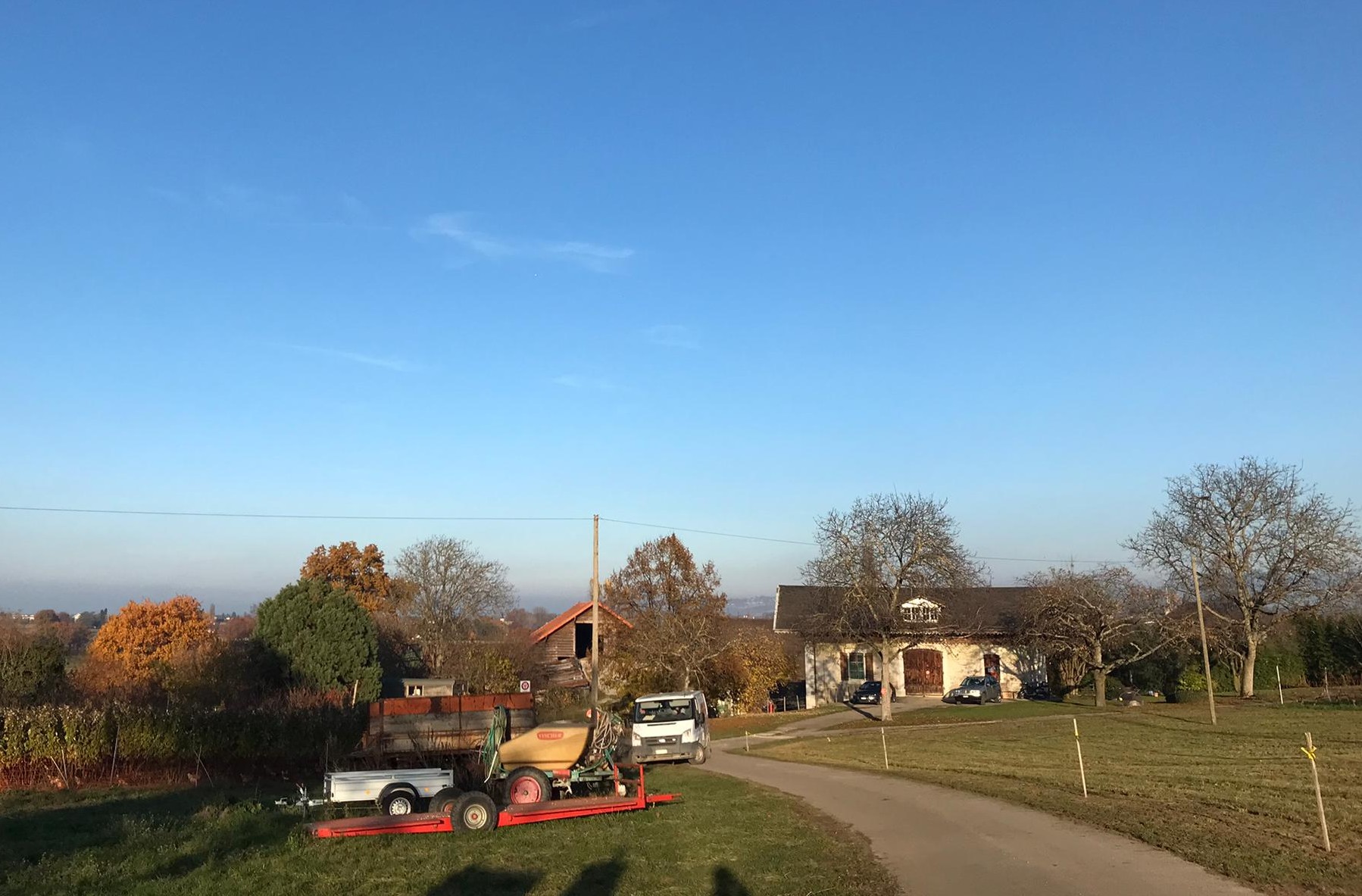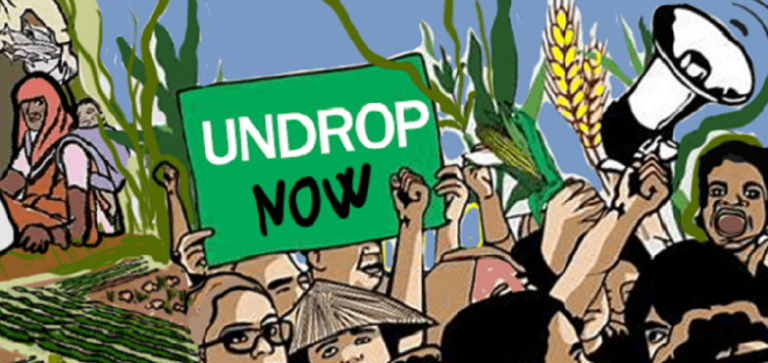Access to Land for Youth in the Canton of Geneva: Barriers and Pathways
In this article, Sonja Muriel Plüss analyses the social, legal and economic barriers to access to land for youth in the canton of Geneva, Switzerland. The paper argues that the current Swiss socioeconomic and legal system of family farming is arranged in a way that not only significantly hinders access to land to youth but thereby also contributes to the dreary disappearance of the Swiss peasantry. While exposing the multiple interconnected hurdles to collective and individual access to land in Geneva, it brings up possible pathways towards for a more inclusive, diversified, and resilient Swiss family farming system in light of the UN Declaration on the Rights of Peasants (UNDROP).
Introduction
In the preamble of the United Nations Declaration on the Rights of Peasants and Other People Working in Rural Areas (UNDROP) the concern for youth leaving agriculture and rural areas because of the lack of opportunities and strenuous conditions of agricultural work is expressed. Ensuring access to land is one of the strategies to facilitate, or safeguard, youth’s commitment to rural and agricultural livelihoods. Following a human rights approach, the UNDROP refers to the right to have access to, use and sustainably manage land and natural resources in articles 5 and 17 (United Nations 2018). Ensuring continued and widespread access to land for new generations of farmers is crucial to upholding a peasant agriculture, in turn fundamental to the food sovereignty of communities. The importance of, but also challenges to, access to land for youth have predominantly been discussed in the context of regions where livelihoods of a high percentage of the population depend on small-scale agriculture, with a particular focus on sub-Saharan Africa (see for instance Gichimu and Njeru 2014; Kosec et al. 2018; Yeboah et al. 2019; White 2019).
However, also in the canton of Geneva in Switzerland, access to land for young people aspiring to engage in agricultural production, and especially for those not inheriting a farm, is a challenge. At the same time, around half of the existing farmers in Switzerland are entering retirement in the current decade and stopping to work their lands (FSO 2021a). The explanation for the seemingly paradoxical situation of unavailability of farms for youth despite high retirement rates lies in the financial, legal and social barriers to access to land for youth. An elaboration of those barriers is followed by a sketch of pathways to lower the barriers that are pursued in Geneva and a reflection on the findings’ revelation of and implications for the development of Swiss agriculture.
The analysis is based on discussions in a round table on access to land at an event in Geneva organised by the Artisans de la Transition (November 17, 2021) and semi-structured interviews. Interviews have been conducted with, firstly, young people engaged in agriculture in the canton of Geneva, mainly from La Touvière. The second interlocutor was Valentina Hemmeler Maïga, the General Director of the cantonal office of agriculture and nature,who is a defining actor in pushing for access to land for youth in Geneva, and, thirdly, Johanna Huber, a doctoral candidate who is studying the access to land in Switzerland. Further information was collected through an email exchange with two employees of the association for small peasants (Kleinbauern-Vereinigung) about their programme on extra-familial farm succession. These data are complemented by a critical reading of Swiss agricultural laws on the one hand, and social science literature on Swiss farmers and agricultural development on the other hand.
Barriers for young (aspiring) farmers to accessing agricultural land
In Switzerland, for activities officially being recognised as farming and eligible for receiving the state’s direct payments, a farmer, farmer family or group does not just require land, but at least one member with a certified agricultural education, a building counting as agricultural infrastructure, machines, and implicitly the money to finance all of these elements. Therefore, the barriers to accessing farmland are only part of the hurdles to starting a farm. Obtaining an agricultural education is accessible and the shortest way only takes two years. In fact, more people obtain the certification to run a farm than there are farms available, which is particularly an issue in the canton of Geneva. Geneva has its own agronomic school, HEPIA, attracting numerous young people from (peri-)urban, non-agricultural backgrounds that graduate without any prospect of inheriting a farm, but wishing to perform the farming profession. Education, but also basic machines and agricultural tools are easily accessible, therefore the focus in this research lies on the constraints to land, and to a lesser extent agricultural infrastructure such as farm buildings, as barriers to carrying out the agricultural profession. The constraints are of interlinked social, legal, and economic nature.
Social constraints: Land for one’s own blood
Social constraints to access to land are predominantly linked to the dominant logic of family agriculture and its associated heritage structures. In order to understand the social logics in agriculture, understanding models of heritage is crucial (Augustins 1989). Indeed, preserving the farm and the family identity connected to it for inheritance is one of the main motivations of farmers in Switzerland to carry out their occupation even in difficult health and financial circumstances (Droz 2017; Forney and Droz 2018, 66). Social factors add a gender dimension to access to land in Switzerland; Historically, daughters and wifes are disadvantaged in matters related to the farm, including succession (Droz et al. 2014; Contzen 2004).
Several social aspects complicate the transmission of a farm. Because the farmers’ identity is generally deeply connected to the farm, the process of farm succession is profoundly emotional and often not tackled early enough (Häberli 2021, 58). Retiring farmers, or farmer couples and families, find themselves suddenly overwhelmed by all the decisions that are connected to handing over a farm. Oftentimes, the farmhouse is not set up for hosting two family units. This poses difficulties in making space for the new generations, as the older generation usually wishes to continue living on the farm. Not only are they connected to the farm, but the lack of savings and pension of retiring farmers complicates the renting of another space (Rossier and Felber 2007, 245). Furthermore, diverging values and ideas on how to run the farm between generations are a common source of conflict (Häberli 2021, 61). Financial as well as value-related concessions are made to preserve the heritage and transmit the farm to a child (Forney and Droz 2018, 50). However, in the case of lack of successors from within the family, making such concessions becomes harder. The simplest solution for retiring farmers in this case is selling or leasing the land and continuing living on the farm, leading to a further farm disappearing.
The case of La Touvière is illustrative of this dynamic. The retired farmer is leasing the farm to the motivated group of young farmers on a 20-year contract. Initially, his son had carried on the business but did not enjoy it enough to continue. Wanting the farm to be sustained and liking the group’s project of social and environmentally friendly farming as an organic farmer himself, the retired owner supported the young group in installing themselves. However, he continues living in the residential house of the farm, meaning the young farmers have to live elsewhere, posing financial but also organisational constraints on them and the farm business. Furthermore, as the farm is rented, there is uncertainty on the medium-term future of the business built up by the young farmers. If one of the owner’s grandchildren wishes to take over the farm, which is the hope of the owner, then the current group has to leave again.
Many young aspiring farmers, like those from La Touvière, increasingly seek organisational forms other than family farming. Wishing for more independence from the farm and a lower financial burden to be carried by an individual, they aim to work as collectives. This is a clear break from the entrenched helvetic family farming model (see for instance Forney and Droz 2018, 51). The typical peasant ethos includes not only a strong logic of family heritage but also an image of a farmer as an independent entrepreneur (Droz 2001). Value clashes in the respect of models of organising a farm hamper farm succession further.
While the system of inheritance and family farming in Swiss agriculture facilitates the farm takeover of one child within the family, it restricts further children and outsiders of the family from performing the farming profession, particularly if they seek organisation models other than family agriculture. The system of family farming and farm inheritance is not just of a social nature, but also anchored in law.
Legal constraints: Entrenching family farming
Three main laws govern agricultural land in Switzerland, aimed at preserving agricultural lands from disappearance, favouring family farming businesses and avoiding speculation on agricultural land. The first law is the Raumplanungsgesetz (Spatial planning act) with its initial version in 1979 which led to a clear differentiation between zones, not least to protect land for agricultural production and food security from urban sprawl. In the demarcated agricultural zones, the possibilities for new construction are strictly limited. Land and infrastructure in the agricultural zones fall under two other laws, namely the Bundesgesetz über das bäuerliche Bodenrecht(agricultural/peasant land law) adopted in 1991 with its latest revision in 2014, and the Bundesgesetz über die landwirtschaftliche Pacht(Law on agricultural lease) adopted in 1985 and also revised most recently in 2014. These laws prescribe that only people with a certified agricultural education can own or lease farms and farmland to ensure its use for farming purposes, thus preserving farmland.
The laws favour transition of farm infrastructure and land within the family, and in case of a lack of interest within the family, its lease to neighbouring farmers. When the farm is sold to a family member, the agricultural/peasant land law provides that it can be done so under the return value (Art. 17). Outsiders to the family, on the other hand, are required to pay the market value which is around two and a half times higher (Droz and Forney 2007, 56). The effect is that very little land and even fewer farms become available and financially accessible for aspiring farmers who do not inherit those infrastructures.
The laws pose constraints on more collective modes of farming. Firstly, if a group of people wishes to farm together, they cannot do so as a collective or association, but have to form a private limited company and designate one member who has an agricultural education to be the principal farmer for receiving the conditional direct payments, a crucial form of subsidies for farming, by the state. This has been done by the group at La Touvière. Secondly, each farm is only allowed to host one business. In a time where coworking spaces are common in offices, the same is not possible for farming. Valentina Hemmeler Maïga mentioned how there are numerous empty buildings in existing farms, also in Geneva, that could be used for entering farmers who might have land but no building. Such shared uses of farms would help economise and make the starting of a farming business more accessible, however it is not allowed under current legislation.
Lastly, the laws protect farmers who are leasing land. Most farmers who stop farming and close their business choose to lease or sell the land to neighbouring farms. Once a farm is closed and its lands disintegrated, it becomes difficult for new generations to re-establish the farm and take back the land. According to Valentina Hemmeler Maïga, the current laws ensure the protection of existing farmer families, but are not aimed at the creation of new peasants. The legal and social constraints are tightly interlinked with economic constraints to accessing land and farms.
Economic constraints: Bigger and less affordable farms
The economic constraints to accessing land are probably the most severe constraints and are mainly resulting from the meagre income that farms generate under the current Swiss political-economic system. Swiss agriculture experienced a wave of liberalisation in the Nineties which led to a decoupling between the situation of farmers and the general well-being of Switzerland. In 2018, the median monthly salary of a Swiss person amounted to 6067 CHF for women and 6857 CHF for men, whereas income for skilled agricultural, forestry and fishery workers lied at 4657 CHF for women and 5302 CHF for men (FSO 2021b), with significant differences between mountain and low-land regions and despite substantially longer working hours and fewer holidays of agricultural workers. The income reflects the low profitability and often even indebtedness of farm businesses, which hinders access to land in several ways.
The costs of buying a farm, especially when it is not inherited, are immense and can hardly be covered by agricultural activity alone (Forney and Droz 2018, 50). Bank loans require aspiring farmers to have the prospect of running a farm that is profitable. Furthermore, to receive bank loans, farms need to be officially recognised as such. Official recognition demands at least the prospects of land, machinery and farm buildings, the securing of which is a struggle in itself for aspiring farmers who do not inherit farms. The costs of taking over a farm from within the family are lower but still substantial. The farm succession in the helvetic family farming system is, in theory, enabled by family capital (ibid, 50), but such family capital is increasingly absent, or even negative. Current farmers oftentimes manage to stay afloat until retirement, but not much beyond. Farmers then rely on the farm infrastructure for their pension. The lack of savings of retiring farmers constrains the selling or leasing of the farm at lower friendship or family prices. The economically and legally easiest solution for retiring farmers without successors is to continue living in the farm rent-free and leasing the land to neighbouring farmers seeking to expand.
Another economic reason for the unavailability of farmland is the development towards larger farms. Farms expand as an answer to the market pressures which favour an economy of scale. However, as farms grow, not only is the number of farms for potential take-over reduced, but those that persist are even more expensive for new generations of farmers due to their larger size, a point stressed by Valentina Hemmeler Maïga and also Marie Brault, engaged in the urban Ferme de Budé. In the experience of Willy Cretegy, a farmer and politician in the Genevan commune Satigny, it is generally the already biggest and most profitable farms that then take over the freed land. Furthermore, the territorial expansion of farms as well as their increased mechanisation require investments often leading to indebtedness and therefore further problematizing succession even within the family (Droz and Forney 2007, 135).
After a farm is taken over, further investments by the new generation are required. The young farmers generally seek to make changes to the way the farm is organised, and explore the possibility of opening other production branches or changing to organic farming. In the ideal case, the farm taken over is already close to the vision of the new generation. Marie Brault brings forward that finding a farm is not just complicated by the problem of general access to land and farm infrastructure, but also by the mismatch between the conditions of most available farms and the specific type of land and farm infrastructure that the aspiring farmers seek. The Association for Small Peasants therefore stresses the need for flexibility by farm seekers in the ideal image of what the farm should look like at the point of take-over, and flexibility from the side of the retiring farmers in their vision of what the farm should look like in the future (Kleinbauern-Vereinigung 2021).
Renting, rather than buying a farm, and making partial investments is the strategy that the team at la Touvière but also the Jardins de Cocagne, one of the oldest collective farms doing contract agriculture, pursue. Renting a farm often comes with further insecurities, especially if the rent contract is for a limited period of time. It complicates long-term investments, such as planting fruit trees. Furthermore, if the owners continue living in the farm building, as is the case with La Touvière, the young farmers are required to pay for housing elsewhere. This is a major problem in the canton of Geneva where the rent in relation to a farmer’s income is tremendous.
Valentina Hemmeler Maïga expresses how the situation of young (aspiring) farmers is intrinsically connected to the situation of retiring farmers. Put differently; there is no solution for the young farmers, if there is no solution for the retiring farmers. However, as the situation of the retiring farmers is linked to how they can economize while still working in the profession, there also needs to be a solution for current farmers. Farmers need to be able to stay afloat and have savings for their pension in order for small-scale peasant agriculture to continue in Switzerland.
A patchwork of pathways to access to land for youth in Geneva
In Geneva, more than in other Swiss cantons, the problem of access to land for youth is recognised and has led to a set of individual, but also administrative strategies. Individual young farmers’ strategies to starting a farm business commonly include renting land and investing partially into the farm, rather than buying one. Crowdfunding has also been used to start the business. Others squat small pieces of unused land temporarily, such as the Collectif Terre Libre did before its closure in 2020, or produce on urban, non-agricultural land, such as the Ferme des Vergers in the agro-eco-neighbourhood in Meyrin. These strategies bring with them their own set of insecurities and constraints, such as the inability of being recognised as an official farm and receiving the federation’s direct payments.
The administration of the cantonal office for agriculture and nature is motivated to tackle the issue of access to land for youth. Geneva was the only canton that responded favourably to the clause for improving access to land for youth in the discussions of the new agrarian politics AP22+, which, however, got suspended. The main guiding document for action on access to land in Geneva is the law on the promotion of agriculture in Geneva, particularly its modifications that were passed in the parliament in 2021, manifested in theLoi modifiant la loi sur la promotion de l’agriculture (Modified law on the promotion of agriculture). Hemmeler Maïga, who played a crucial role in drafting the modifications, was inspired and guided by the UNDROP. The modified law states that it is the goal and responsibility of the canton to facilitate the installation and take-over of farm businesses by reinforcing the access to information and to counselling in the frame of the attribution of buildings and agricultural lands belonging to the state (Art. 1d, Art. 8c).
The modified law gives justification to actions that are already underway in practice, as well as to plan further actions. For instance, since two years ago, cantonal land that is becoming available needs to be published on the internet to grant all people equal access to the information. However, only around 600 ha of the total 10’000 ha of the agricultural land of the canton belongs to the state, and little more to the communes. The Geneva administration therefore encourages the communes to follow the same strategy to increase transparency, and furthermore sensibilise farmers who are (close to) retiring to start the succession process early so that farms can be preserved.
Much of the action in Geneva revolves around finding loopholes in the current federal legislation. If young farmers find land, but not a farm building, the cantonal administration sometimes accepts temporary buildings such as sheds or tunnels as agricultural buildings so that the farm can officially be recognised as such. The administration furthermore tries to give authorisations to build farm infrastructures to young people with a salient, long-term project.
A further set of actions led by Hemmeler Maïga is the regional and national mobilisation for the topic of access to land for youth. Hemmeler Maïga has initiated a meeting with all the agricultural offices from the French speaking part of Switzerland and found that the problems were shared across the region. In the beginning of 2022, Hemmeler Maïga initiated a meeting with the agricultural offices from all cantons to exchange about further strategies to improve youth’s access to farming more promptly, as long as there is no change in the national legislation.
However, Hemmeler Maïga stresses that only 10% of the power for shaping agricultural policies lie with the canton, and the other ninety percent with the federation. The actions possible at the cantonal administration are very limited and more radical policies to improve the situation of current and future farmers, such as fixing prices for food products to improve farming viability, need to come from the national legislature.
Switzerland’s choice between a ‘natural’ decay of peasantry or a thriving peasantry through access to land for youth
Access to land is a concept whose implications and symbolics transcend the physical availability of land for farmers. The reason for access to land for farming, particularly for youth, to receive widespread attention is because of its crucial role in the sustained existence of small- and medium-scale farms that produce diverse foods for local communities and thus support food sovereignty. The accessibility of land defines if the profession, lifestyle and know-how of farming can persist in diversity over generations. If the development of Swiss agriculture continues in the same trends, agriculture will take the form of, on the one hand, not more than a hobby, at the expense of the quality of work on the farm (Droz and Forney 2007, 152–53), and, on the other hand, large mechanised, industrialised farms likely to be less sustainable and financially resilient (van der Ploeg 2020). Access to land is not a singular issue that can be solved by making more land physically available, but for access to land to be fulfilled in a manner that allows new generations of farmers to make use of it in a sustainable way, it requires favourable social, legal and, particularly, economic conditions.
Before discussing some changes that could encourage access to land for youth on the social, legal and economic front, it is crucial to underline that the problem of access to land for youth in Switzerland is in several ways a privileged one. Sufficient economic opportunities exist for youth outside of agriculture, and overall livelihoods are not deeply dependent on agriculture. Already now, farmer families earn roughly a third of their income outside of the agricultural activities (FSO 2021c). Furthermore, there is an absence of land grabbing, corporate take-over or forced displacement, which are the more imminent threats to access to land. Rather, the agrarian politics of Switzerland triggers a ‘natural’ – so the official euphemism – death of farms by encouraging an economic environment in which farms are pressured to grow, to be run as a hobby, or to disappear. The farms disappear through farmers’ entering of retirement without successors (Droz and Forney 2007, 76). The disappearance is slow, however only in relation to a human’s lifespan and not in the perspective of larger history.
The UNDROP can function as a guide to improve access to land in the fulfilment of the right to land (Golay 2020). The first crucial aspect for the Swiss case is the freedom from discrimination (Art.3.3). This would mean the removal of gendered discrimination in the process of farm inheritance within the family, and particularly the discrimination of aspiring farmers who do not have the prospect of inheritance. After all, the UNDROP does not just cover current peasants, but also people aspiring to work the land by including them in the definition of peasants (Art 1.1). A second article of the UNDROP relevant to the Swiss case points to the state’s responsibility to remove lack of access to economic resources (Art 17.2).
To increase sensibilisation on succession of farms outside of the family, especially if there is no successor within the family, is one way to lower the discrimination in access to land. This solution on the social level is pursued by the Association for Small Peasants and their programme on extra-familial farm succession, which is supported by the federal government. The association encourages and helps farmers to start planning their retirement and the farm succession early. That way, they are more likely to pass on the farm successfully instead of being in a hurry and seeing no alternative to closing the farm and selling or leasing the land. In October 2021, the association had 130 profiles of people searching for a farm and 16 profiles of farms for take-over (Kleinbauern-Vereinigung 2021). Further engagement by the federal government on the topic of succession and retirement is already under way (FOAG 2021). However, even when there is a willingness to give the farm to someone outside the family, several barriers remain. Some of the main ones, according to Bettina Erne working for the extra-familial farm succession programme, are the ability to sustainably finance the business from the side of the successors, and the ability and willingness to either co-live or leave the farm building from the side of the retiring farmers. Actions to lower the barriers to access to land for youth on a social and awareness level therefore need to be supported by actions on other levels.
Valentina Hemmeler Maïga, as well as Laurent Vu from the collective farm Jardins de Cocagne believe that there needs to be an opening in the law for more collective juridical forms to run farms, outside of the dominant family model. Furthermore, the current set of laws favour family agriculture and discriminate against people outside of agricultural families. However, according to Johanna Huber, also progressive actors such as the leftist peasant union Uniterre – member of La Vía Campesina – are not convinced that changing the laws on land will be fruitful. To a large extent, the current laws protect agricultural land from urbanisation, speculation and corporate grab, and thus help preserve family, peasant agriculture and access to land more broadly. Hemmeler Maïga, on the other hand, believes that lawyers are smart enough to formulate articles that can facilitate access by young farmers, especially either farmers without the prospect of inheriting a farm, or wanting to work in a collective, or both, without risking land appropriation by corporate or financial actors.
Another approach for improving access to the farming profession is improving the economic situation of farming, linking to the UNDROP article on access to economic resources (Art 17.2). Laurent Vu wishes for more financial support for young farmers. Such financial support is partially already in place, as the Swiss federal government provides loan-free credits for farm-takeover. However, aspiring farmers still depend also on capital from other sources, including the bank. Overall, the farming activity needs to be profitable in the medium-term for initial investments and mortgages to be paid off, and for farmers to finance their retirement. Structural changes around the prices farmers can obtain for their produce, not least through reconsidering international economic agreements, rather than one-time financial injections are required, particularly to counteract the current trends of agriculture increasingly becoming an economy of scale, leading to further farm disappearance.
Conclusion
There are interlinked social, legal and, most of all, economic barriers to access to land for youth in Geneva and Switzerland more broadly, particularly for aspiring farmers from non-agricultural families. What first seems to be a paradox – a large number of farmers discontinuing their activities while some young people struggle to find a farm to take over – is actually logically interrelated. Farms disappear and young people struggle to take over farms because farming is not a sustainably profitable activity anymore in Switzerland. Although in the administration of Geneva canton there exists an awareness of the issue and a willingness to improve access to land for youth, the underlying problem of the economic unprofitability of small and medium-scale farming needs to be tackled on a national level. The question of access to land for youth is only a subquestion of a larger one: Does Switzerland want to continue on the path of the ‘natural’ disappearance of farms, or does it want a diversified, vibrant, resilient agriculture for generations to come? The second path is the path of food sovereignty, for which the UNDROP can function as a guiding document.
Bibliography
National and Cantonal Laws
- Bundesgesetz über das bäuerliche Bodenrecht (Agricultural/peasant land law), 4. Oktober 1991 (Stand am 1. Januar 2014).
- Bundesgesetz über die landwirtschaftliche Pacht (Law on agricultural lease), 4. Oktober 1985 (Stand am 1. Januar 2014).
- Loi modifiant la loi sur la promotion de l’agriculture (Modified law on the promotion of agriculture), du 1er juillet 2021.
- Raumplanungsgesetz (Spatial planning act), 22. Juni 1979.
Literature
———. 2017. ‘Amour, famille et entreprise : la transmission du patrimoine au sein de l’entreprise familiale’. Recherches familiales n° 14 (1): 9–22.
Häberli, Isabel. 2021. ‘Die Hofnachfolge ganzheitlich und frühzeitig angehen’. Agrarforschung Schweiz, no. 12: 57–63.
Kleinbauern-Vereinigung. 2021. ‘Newsletter Ausserfamiliäre Hofübergabe’.
White, Ben. 2019. ‘Rural Youth, Today and Tomorrow’. 48. IFAD Research Series. IFAD.
Yeboah, F. K., T. S. Jayne, M. C. Muyanga, and J. Chamberlin. 2019. ‘Youth Access to Land, Migration and Employment Opportunities: Evidence from Sub-Saharan Africa.’ IFAD Research Series, no. 53. https://www.cabdirect.org/cabdirect/abstract/20203324917.
1 Cover picture: Land, machinery and farm buildings, together making up the infrastructure necessary for an officially recognised agricultural enterprise in Switzerland. Photo taken by the author at La Touvière in Meinier, Geneva (2021)







